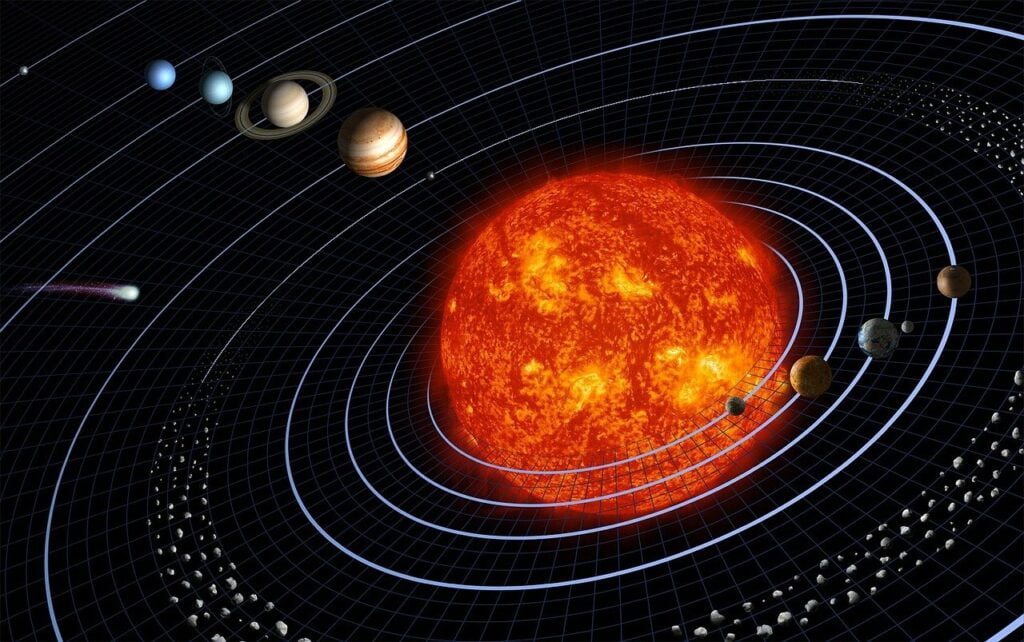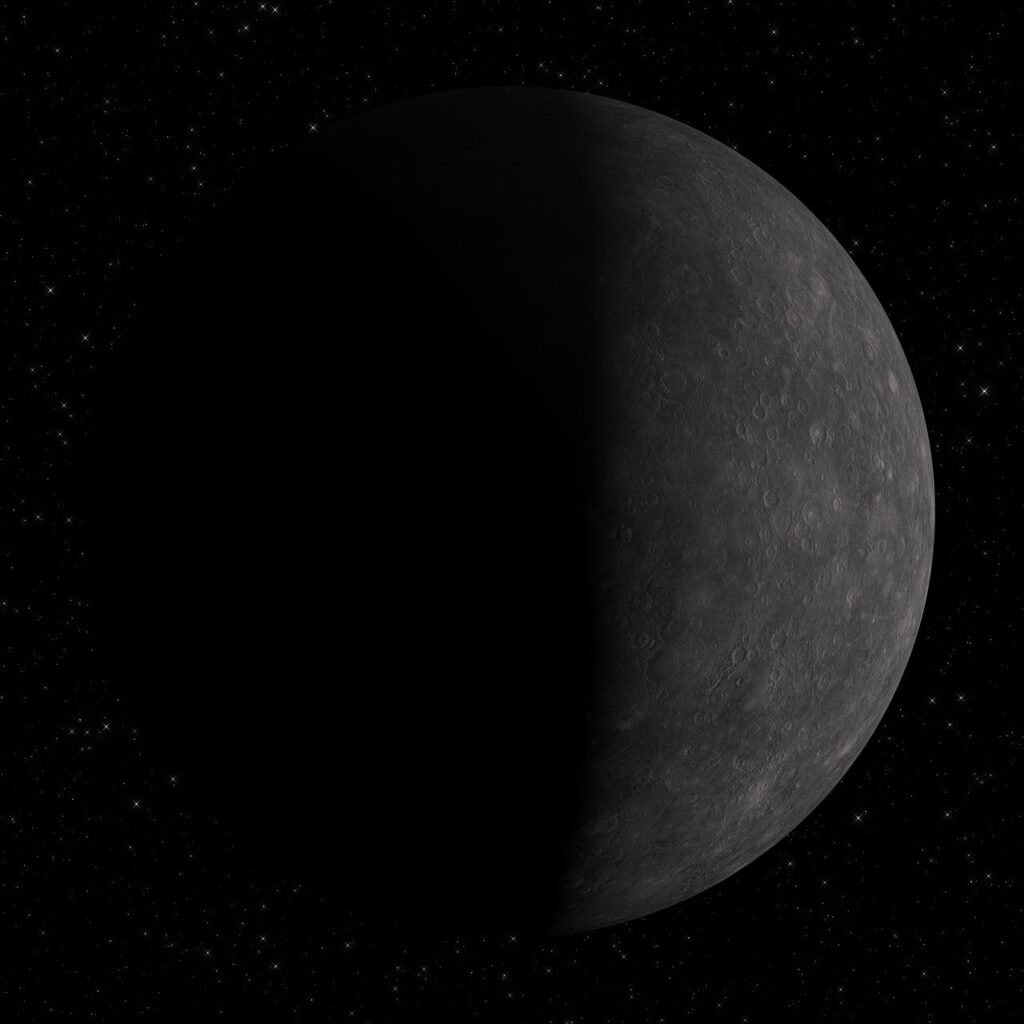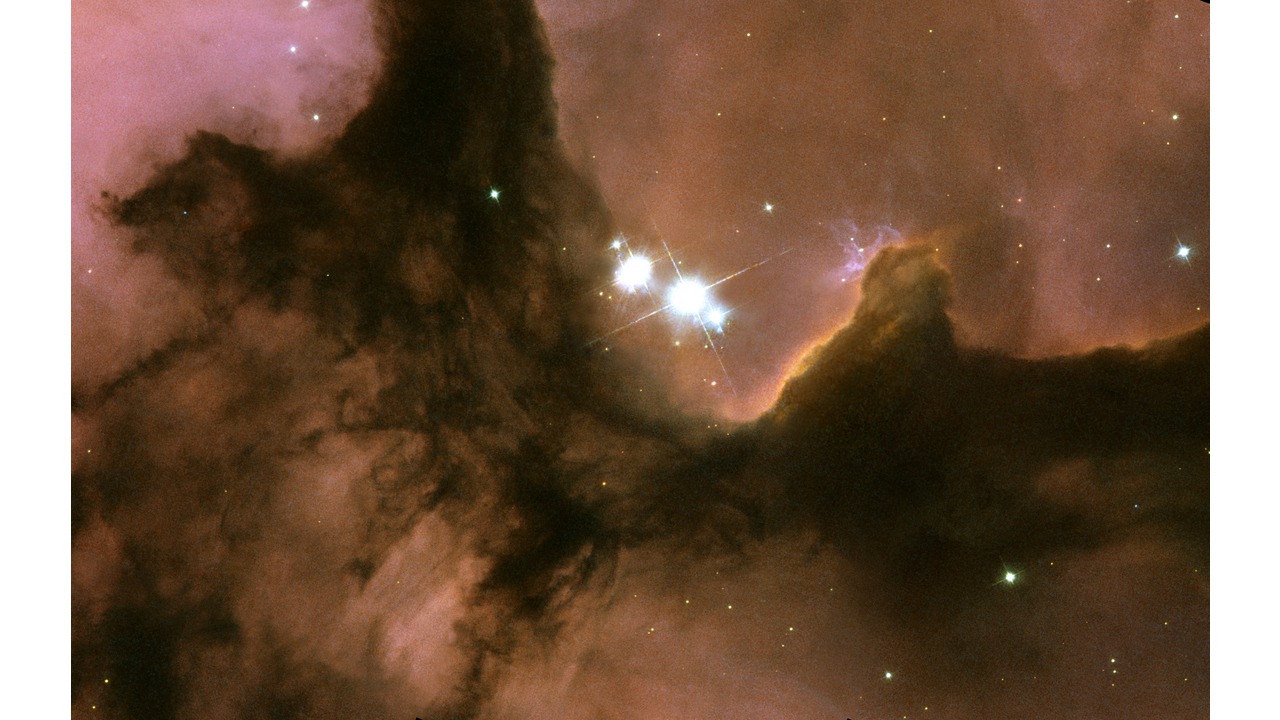
Gazing up at the night sky, our eyes are drawn to breathtaking celestial tapestry woven with stars, dust, and nebulae. Among these ethereal wonders lies the Trifid Nebula, a captivating region where newborn stars ignite, illuminating intricate gas and dust tendrils. This cosmic spectacle, also known as Messier 20 (M20) and NGC 6514, holds a wealth of secrets about the birth and evolution of stars, beckoning astronomers and space enthusiasts alike.
General Information about The Trifid Nebula
Gazing skyward, our eyes become captivated by the Milky Way’s breathtaking tapestry, woven with stars, dust, and nebulae. Among these ethereal wonders lies the Trifid Nebula (Messier 20, NGC 6514), a captivating H II region where infant stars ignite, illuminating intricate tendrils of gas and dust. This cosmic spectacle beckons astronomers and space enthusiasts alike, holding secrets about the birth and evolution of stars within its gaseous embrace.
A Celestial Treasure Unearthed:
The Trifid Nebula’s journey into scientific renown began in 1764. Renowned comet hunter, French astronomer Charles Messier, stumbled upon this celestial gem while meticulously charting the night sky. He catalogued it as the 20th entry in his now-famous Messier List, solidifying its place among other remarkable deep-sky objects.
Threefold Beauty Unveiled:
The Trifid Nebula’s name aptly reflects its striking appearance. “Trifid” translates to “three-lobed,” referring to its distinct, wispy lobes separated by dark dust lanes. These lanes are sculpted by intense radiation from young, hot stars embedded within the nebula. Imagine delicate ribbons of cosmic dust, sculpted by stellar winds and radiation, painted against a backdrop of glowing ionized gas, swirling in a celestial ballet of creation.
A Beacon in the Archer’s Bow:
The Trifid Nebula resides within the constellation Sagittarius, the mythical archer aiming his celestial bow towards the heart of the Milky Way. To locate this cosmic gem, look towards the southwest, roughly 2 degrees northwest of the even brighter Lagoon Nebula (M8). While not visible to the naked eye due to its faintness, even a small telescope reveals its breathtaking form. Through the eyepiece, the Trifid Nebula transforms into a captivating spectacle, showcasing its intricate structure and vibrant hues.
A Voyage Beyond Our Earthly Realm:
This celestial wonder resides a staggering 9,000 light-years away from Earth, placing it deep within the Milky Way’s spiral arms. This vast distance underscores the immense scale of the universe and the awe-inspiring journey light takes to reach our eyes. It is a sobering reminder of the vastness and wonder that still await exploration beyond our planet.
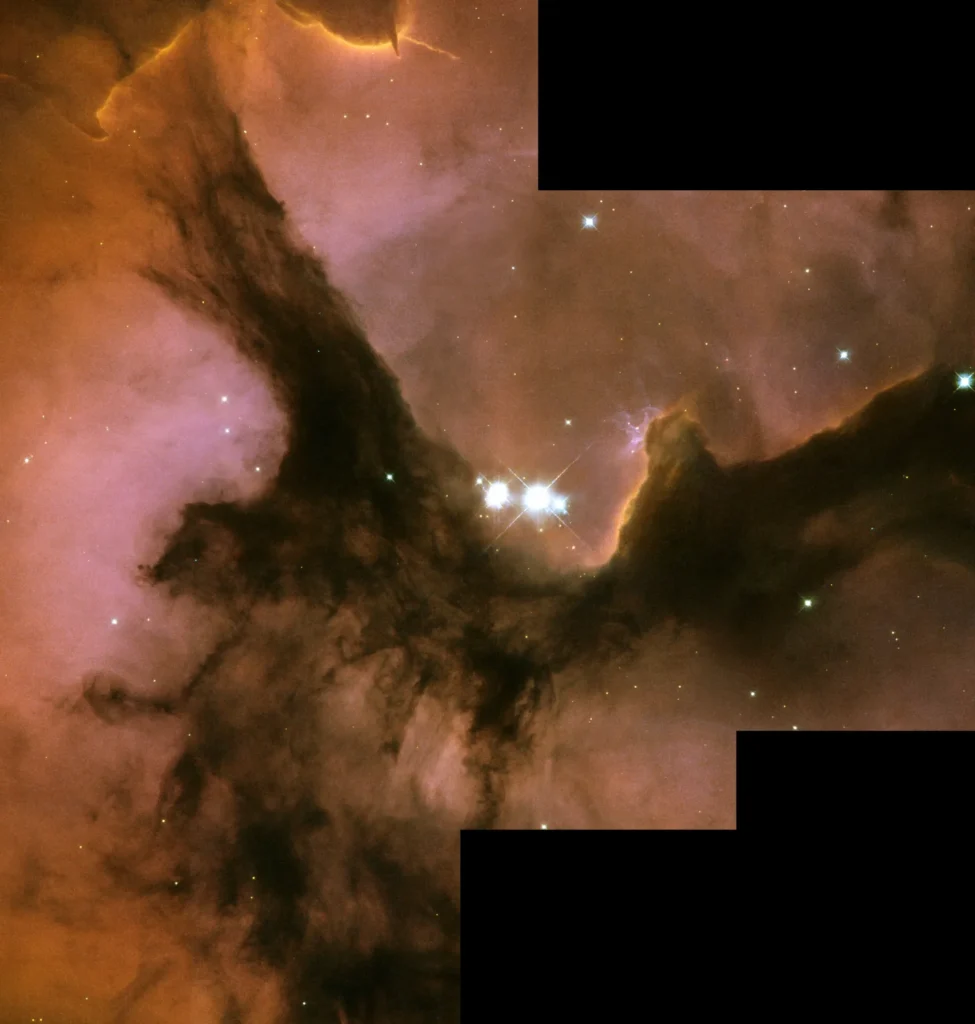
Physical Characteristics of the Trifid Nebula
In our previous voyage, we marveled at the Trifid Nebula’s celestial beauty. Now, let’s delve deeper into its physical characteristics, uncovering the secrets this stellar nursery holds.
A Majestic Multi-Lobed Tapestry:
Imagine a majestic cosmic cloud sculpted by celestial winds and radiation. This is the Trifid Nebula, not simply a single structure, but a captivating arrangement of three distinct lobes. These prominent “lobes” are composed of ionized gas, primarily hydrogen, glowing like an ethereal neon sign under the intense ultraviolet light from young, hot stars embedded within. However, these lobes aren’t the only players in this cosmic drama.
Dazzling Darkness: The Role of Dust Lanes:
Separating the luminous lobes are dark, wispy tendrils called dust lanes. These lanes are composed of cold interstellar dust, primarily carbon and silicate particles, acting like cosmic curtains shrouding the processes within. These dust lanes are not merely passive bystanders; they play a crucial role in the nebula’s story. They act as cradles, where the cold dust and gas clump together, providing the dense material needed for future star formation.
Dancing with Starlight: Interaction and Evolution:
The interplay between the dust lanes and the energetic radiation from young stars is a delicate dance. The intense ultraviolet light carves and shapes the dust lanes, creating the intricate tendrils we see today. However, this radiation also heats the dust, triggering the collapse of dense clumps within the lanes, eventually igniting new stars. This ongoing interaction paints a dynamic picture of the nebula’s ever-evolving nature.
Titanic Proportions: Size and Mass:
The Trifid Nebula stretches across a vast expanse, spanning approximately 40 light-years in diameter. To put this in perspective, our entire solar system, including the farthest reaches of the Kuiper Belt, could comfortably fit within this cosmic realm. The nebula’s estimated mass is an astounding 8,000 times the mass of our Sun, showcasing the immense reservoir of material available for future star formation.
A Galactic Gumbo: Chemical Composition:
Like a cosmic gumbo, the Trifid Nebula boasts a rich blend of elements. Hydrogen reigns supreme, constituting roughly 90% of the nebula’s gas, followed by helium at around 8%. Other elements like oxygen, nitrogen, and carbon sprinkle in smaller proportions, forming the building blocks for future stars and planetary systems. These elements are also present in the dust, influencing its opacity and ability to cool and condense, ultimately impacting star formation.
Fueling the Stellar Dance: Dust’s Vital Role:
Dust plays a critical role in the star formation process. It acts as a thermal blanket, allowing gas clouds to cool and condense. Once cold and dense enough, these clouds become gravitationally bound, eventually collapsing to ignite new stars. Additionally, dust shields young stars from the harsh ultraviolet radiation emitted by their older siblings, allowing them to grow and mature.

The Trifid Nebula role in star formation
Our exploration of the Trifid Nebula unveils a vibrant stellar nursery, where gas and dust transform into celestial newborns. In this chapter, we delve into the heart of this cosmic cradle, witnessing the birth of stars and unraveling the secrets of their fiery fates.
A Blazing Beacon: The H II Region Classification:
The Trifid Nebula proudly wears the badge of an H II region, a cosmic haven where star formation thrives. But what makes it worthy of this title? H II regions, like the Trifid, are fueled by massive, young stars. These stellar behemoths emit intense ultraviolet radiation, stripping electrons from nearby hydrogen atoms, creating a sea of ionized hydrogen, hence the “H II” designation. This hot, glowing gas paints the nebula’s lobes with its signature ethereal hues.
A Stellar Baby Boom: Inside the Nursery:
Within the Trifid Nebula, star formation isn’t just a possibility; it’s a bustling reality. Dense pockets of cold gas and dust, cradled within the dust lanes, become the seeds of future stars. As gravity takes hold, these stellar embryos, called protostellar cores, collapse and heat up, igniting the nuclear furnace at their core. The Trifid Nebula pulsates with the energy of these young stars, evident in the vibrant hues and intricate structures visible through telescopes.
Stellar Siblings: Clusters and Jets:
Star formation rarely occurs in isolation. The Trifid Nebula boasts several stellar clusters, groups of young stars born within the same cosmic cloud. These clusters, like NGC 6530, showcase a diverse stellar family, ranging from low-mass dwarfs to giants, each playing a role in the nebula’s dynamic ecosystem. But the stellar drama doesn’t end there. As young stars ignite, they spew out powerful jets of material, called protostellar jets, carving dramatic features within the nebula and injecting energy and momentum into the surrounding gas.
Giants in the Making: High-Mass Stars and their Fiery Finale:
Not all stars are created equal. The Trifid Nebula also harbors the birth of massive stars, stellar behemoths with ten or more times the Sun’s mass. These giants burn bright and fast, shaping the nebula’s environment through their intense radiation and powerful winds. However, their fiery lives come with a dramatic finale. These massive stars are destined to explode in fiery supernovae, enriching the interstellar medium with heavy elements and potentially triggering further star formation in the nebula’s future.
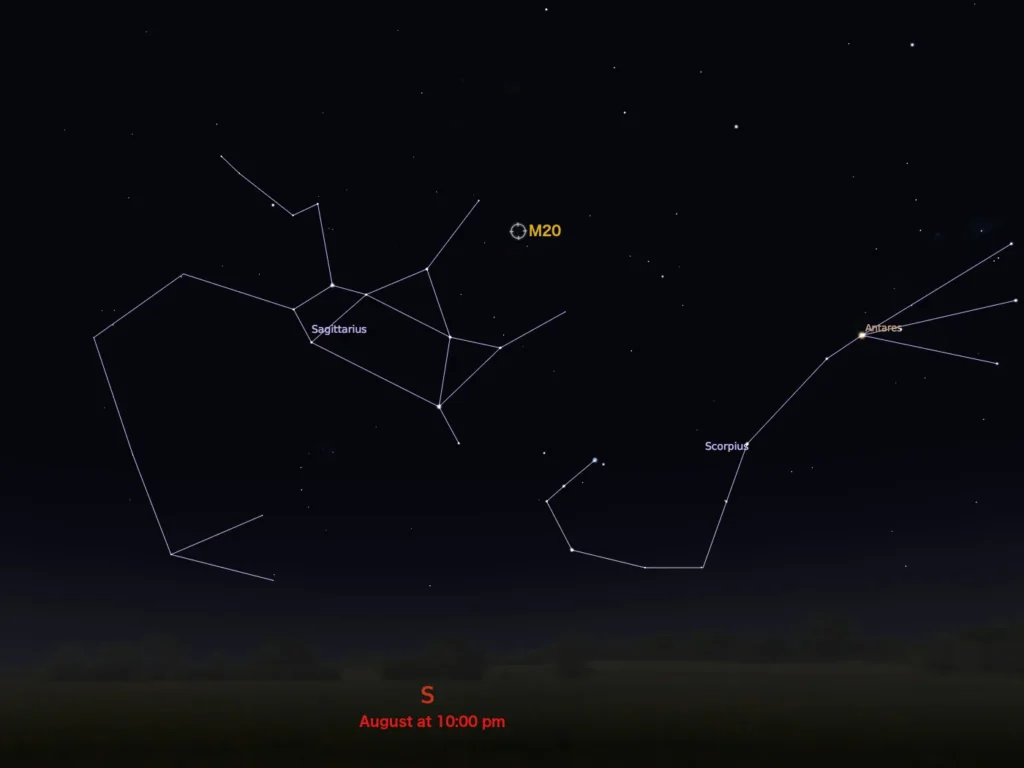
Interstellar Medium
Our celestial voyage through the Trifid Nebula reaches its final chapter. Here, we delve into the interstellar medium, the vast cosmic canvas upon which this stellar drama unfolds. Witness how dust and gas sculpt the nebula’s ethereal beauty, how they fuel the birth of stars, and how their dynamic dance shapes the future.
A Cosmic Canvas: Dust and Gas Clouds Take Center Stage:
Imagine the Trifid Nebula as a masterpiece painted not with pigments, but with swirling clouds of dust and gas. These interstellar clouds, primarily composed of hydrogen and helium, are the raw materials for star formation. Dust plays a dual role: acting as a cosmic shield, allowing gas to cool and condense, and sculpting the nebula’s intricate structure by absorbing and scattering starlight. The delicate interplay between these clouds and young stars defines the nebula’s ever-evolving form.
Denser Pockets: Molecular Cloud Cores and Stellar Seeds:
Within the Trifid Nebula’s vast expanse, denser regions called molecular cloud cores harbor the potential for future star formation. Here, hydrogen molecules, typically resistant to clumping, bind together due to the cold temperatures and shielding provided by dust. These dense cores become the cradles of future stars, waiting for the gravitational dance to begin. As the core collapses, its internal pressure and temperature rise, eventually igniting the nuclear fusion that gives birth to a new star.
A Sea of Charged Particles: Ionized Gas Interacts:
The Trifid Nebula isn’t just a passive canvas; it pulsates with the energy of its young stars. These stellar giants emit intense ultraviolet radiation, stripping electrons from nearby hydrogen atoms, creating a sea of ionized gas, or plasma. This hot, glowing gas, primarily composed of charged protons and electrons, interacts dynamically with the surrounding medium. It carves out the nebula’s lobes, triggers further star formation by compressing nearby gas clouds, and influences the overall structure and evolution of the nebula.
A Cycle of Creation and Destruction:
The interstellar medium within the Trifid Nebula is not static; it’s a dynamic ecosystem where creation and destruction are intricately linked. Stars born from gas and dust eventually die, enriching the medium with heavier elements. Supernova explosions from massive stars trigger further star formation, while stellar winds and radiation sculpt the surrounding clouds. This continuous cycle ensures the ongoing drama of star birth and death, weaving a tapestry of celestial beauty within the Trifid Nebula.
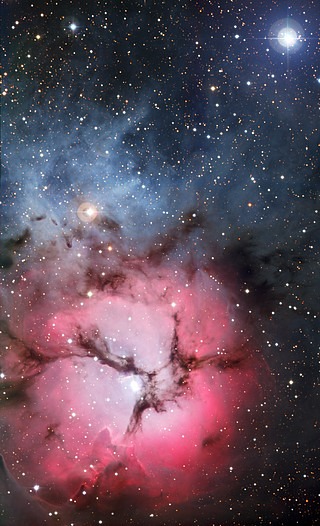
The Trifid Nebula bond with Open Clusters
The Trifid Nebula isn’t an isolated entity; it’s part of a grander stellar family. Embedded within its gaseous embrace lies the young open cluster NGC 6530, home to hundreds of newborn stars. This co-evolution is no coincidence. The nebula’s dust and gas clouds provided the birth material for both the cluster and the nebula itself. Studying these young stars in the cluster helps us understand the early lives of stars born within the nebula, offering a glimpse into the past of the Trifid itself.
A Glimpse into the Future: Unveiling the Nebula’s Destiny:
Gazing upon the Trifid Nebula, we can’t help but wonder about its future. The massive stars currently illuminating the nebula burn bright but short. One day, they will explode in fiery supernovae, enriching the interstellar medium with heavy elements and potentially triggering a new wave of star formation. The remaining stars, with longer lifespans, will eventually exhaust their fuel and fade away, leaving behind white dwarfs or neutron stars. The nebula itself will slowly disperse, its gas and dust returning to the vast interstellar medium, ready to fuel the birth of future stars and planetary systems.
Unveiling the Secrets: Instruments and Research Ongoing:
Our understanding of the Trifid Nebula is a testament to the power of human curiosity and technological advancement. Powerful telescopes like Hubble and ground-based observatories like ESO’s Very Large Telescope have peered deep into the nebula, revealing its intricate structure and dynamics. Spectroscopic observations unveil the chemical composition of the gas and dust, providing clues about its origin and evolution. Ongoing research continues to unravel the mysteries of star formation, supernovae, and the complex life cycle of interstellar material within the Trifid Nebula.
The Trifid Nebula, with its mesmerizing beauty and intricate processes, reminds us that we are part of a larger cosmic story. From the stardust in our bodies to the ongoing dance of birth and death within this celestial jewel box, the Trifid Nebula connects us to the vastness and wonder of the universe. As we continue to explore and learn, this cosmic beacon may yet reveal even more secrets about the origins and destiny of our own place in the grand tapestry of the cosmos.
Concluding Our Exploration
As we conclude our exploration of the Trifid Nebula, we are left with a sense of awe at the intricate processes that govern the birth and death of stars. This cosmic jewel box holds not only secrets about stellar formation but also serves as a window into the grand story of our universe. The Trifid Nebula reminds us that we are all interconnected threads within the cosmic tapestry, born from the dust and gas of stars long gone, destined to return to the interstellar medium, fueling the birth of future generations of stars.

